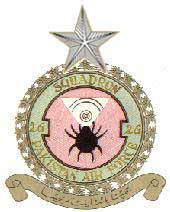|
No 26 Squadron was raised on 30th August 1967 under its first Commanding Officer Wing Commander Rehmat Khan, to systematize the operational training of fighter pilots on the F-86. It was originally located at Masroor but later moved to Peshawar with its complement of Sabres. For about ten years it was the only unit of its kind and can proudly claim to have trained over 300 fighter pilots for the PAF. In fact a majority of the present combat force of the PAF was introduced to fighter operations in this squadron which also has the distinction of graduating over 150 trainees from other friendly countries.
The squadron participated in the 1971 war under the command of Wing Commander S A Changazi. It flew over three hundred sorties in the air defence, counter air and close air support roles. IAF bases at Srinagar and Awantipura were frequently attacked by the daring pilots of 26 Squadron throughout the war. The unit also flew close support missions in the Chamb and Shakargarh sectors.
In addition to hitting the enemy on the ground the Squadron's pilots also challenged him in the air where they destroyed 7 and damaged 2 enemy aircraft. The kills included front line Indian Air Force fighters, some of which were a generation newer than the faithful old Sabres of 26 Squadron. These kills were achieved during classic aerial engagements as well as during pursuit of with drawing enemy fighters. Flight Lieutenant Salim Baig Mirza shot down a Gnat over Srinagar and a Hunter close to Peshawar; both kills were confirmed through target wreckage. Squadron Leader M Aslam Chaudhary flew a total of fifteen missions before he went down fighting valiantly. On 10th December 1971 while leading a section of two F-86Fs on a close support mission in the Chamb sector his flight was attacked by six Indian Air Force Hunters. Totally outnumbered he chose to hold his ground and fight the enemy. In the ensuing combat he was apparently shot down by one of them and was officially declared missing in action. For his courage and devotion to duty he was decorated with Sitara-i-Juraat (posthumous). Flight Lieutenant Fazal Elahi flew intensively during the first two days of the war. He was never daunted and displayed exemplary courage and determination for his young age. On 8th December 1971, while on a close support mission, his aircraft was hit by ground fire which resulted in its disintegration in the air. He was awarded Sitara-i-Juraat posthumously.
By the end of the 70s, the Sabre had become obsolete and it became essential to replace the old faithful. In December 1980, the Squadron was reequipped with Chinese-built F-6s, and designated an air superiority squadron. Four years later, the squadron's F-6s were replaced with A-5s and its role changed to a tactical attack squadron.
At a solemn ceremony held on 27th April 1982, Mir Ali Ahmed Khan TaIpur, the minister of defence, awarded the squadron colour to the unit. The colour has always been a symbol of pride and a reminder to the unit personnel of the high traditions, achievements and sacrifices of their predecessors. The Squadron won three top trophies of the PAF in the year 1985, after converting to A-5 aircraft. These were the Professionals trophy, the flight safety trophy and the command armament trophy. |

